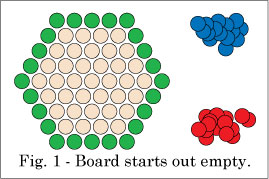
Two players, Red and Blue, take turns adding stones of their own color to unoccupied cells on the board, starting with Red.
Sometimes a player will add more than one stone on a turn. There will always be a move available. Passing is not allowed.
Draws cannot occur in Flume. Mark Steere designed Flume in January 2010.
Flume makes use of the pie rule.
STONE PLACEMENT
Color doesn't matter when placing stones. Red stones, blue stones and the green "stones" surrounding the board
are all treated the same. Purple stones are used in the diagrams to signify red or blue stones. It doesn't matter which.
You can add a stone to a cell not adjacent to any stones, as shown in Figure 2. You can add a stone to form exactly one connection with another stone (red or blue), as
shown in Figure 3.


Here are some example legal moves with 0 or 1 inter-stone connections.
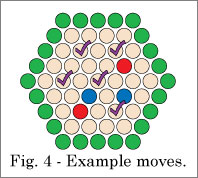
You can add a stone forming 2 connections, but only as illustrated in Figures 5a and 5b, not 5c.
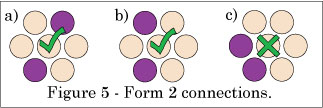
Here are some example moves with 2 connections, legal and illegal.
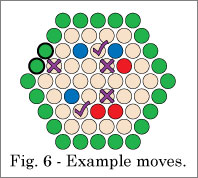
You can add a stone forming 3 connections, but only as illustrated in Figures 7a and 7b, not 7c.
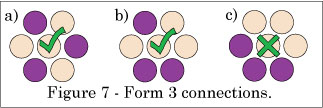
Here are some example moves with 3 connections, legal and illegal.
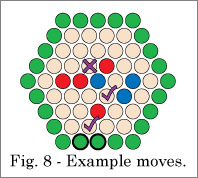
You can add a stone forming 4 connections.
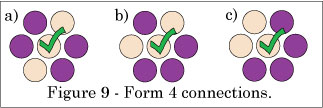
Here are some example moves with 4 connections, all of which are legal.
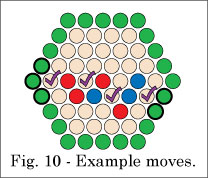
ILLEGAL MOVES
Figure 11 shows the two illegal move types in Flume.
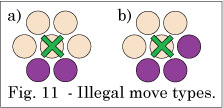
Here are some examples of illegal moves.
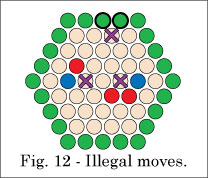
MULTIPLE MOVE SEQUENCES
If you add a stone which forms 5 or 6 connections with neighboring stones of any color (red, blue, green, or combinations thereof), you have to place another stone while it's still
your turn. And so on. Your turn concludes when you place a stone that forms 4 or less connections with neighboring stones.
Forming a 5 way or 6 way connection is not mandatory.
Figure 13 shows a multiple move sequence for Red. Red makes a 5 way connection in 13b, a 6 way connection in 13c and a 1 way connection in 13d.

Figure 14 shows a multiple move sequence for Blue. Blue makes a 5 way connection in 14b, a 5 way connection in 14c and a 4 way connection in 14d. Blue could have claimed 5 cells but he only claimed 3, a winning strategy in this case.

OBJECT OF THE GAME
The object is to have the majority of stones on the board.
AUTHOR'S NOTE
Feel free to publish this rule sheet, and to program the
game of Flume for online or offline play. No licensing fee or royalties are
expected. However please donít change the name or the rules, and please
attribute the game to me, Mark Steere. My other games can be found at
marksteeregames.com.